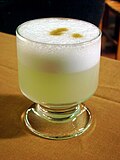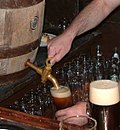Portal:Drink
The Drink Portal
A portal dedicated to all beverages
Introduction

A drink or beverage is a liquid intended for human consumption. In addition to their basic function of satisfying thirst, drinks play important roles in human culture. Common types of drinks include plain drinking water, milk, juice, smoothies and soft drinks. Traditionally warm beverages encompass coffee, tea, and hot chocolate. Caffeinated drinks that contain the stimulant caffeine, have been consumed for centuries.
In addition, alcoholic drinks such as wine, beer, and liquor, which contain the psychoactive substance ethanol, have been part of human culture for more than 8,000 years. Non-alcoholic drinks typically refer to beverages that are traditionally alcoholic—such as beer, wine, or cocktails—but are produced with a very low alcohol by volume content. This category includes beverages that have undergone processes to remove or significantly reduce alcohol, such as non-alcoholic beers and de-alcoholized wines. (Full article...)
Selected article -
- is open to the public without membership or residency
- serves draught beer or cider without requiring food be consumed
- has at least one indoor area not laid out for meals
- allows drinks to be bought at a bar (i.e., not only table service)
The history of pubs can be traced to taverns in Roman Britain, and through Anglo-Saxon alehouses, but it was not until the early 19th century that pubs, as they are today, first began to appear. The model also became popular in countries and regions of British influence, where pubs are often still considered to be an important aspect of their culture. In many places, especially in villages, pubs are the focal point of local communities. In his 17th-century diary, Samuel Pepys described the pub as "the heart of England"; pubs have been established in other countries in modern times.
Although the drinks traditionally served include draught beer and cider, most also sell wine, spirits, tea, coffee, and soft drinks; many pubs offer meals and snacks, and those considered to be gastro-pubs serve food in a manner akin to a restaurant, and many pubs also host live music or karaoke.
A licence is required to operate a pub; the licensee is known as the landlord or landlady, or the publican. Often colloquially referred to as their "local" by regular customers, pubs are typically chosen for their proximity to home or work, good food, social atmosphere, the presence of friends and acquaintances, and the availability of pub games such as darts or pool. Pubs often screen sporting events, such as rugby, cricket and football; the pub quiz was established in the UK in the 1970s. (Full article...)
Did you know? -
- ... that the chairman of the board of a Texas TV station was found to have died from drinking cyanide-laced cola?
- ... that a Thompson Seattle rooftop bar distributes drinks from copper containers shaped like flamingos?
- ... that some insects drink the tears of their predators?
- ... that instead of drinking liquor with prospective clients, Arthur Harrison Motley sent them notes written in red pencil crayon, 10,000 times a year?
- ... that most cocoa in Samoa is consumed locally as a drink known as koko Samoa?
- ... that trembleuse cups and saucers enabled people with unsteady hands to drink hot beverages?
General images -
Selected image -
Selected biography -
Pierre Brejoux was Inspector General of the Appellation d'Origine Controlee Board, which controls the production of top French wines. he served as an expert wine taster in the Paris Wine Tasting of 1976. In the blind tasting, California wines won both the red and white wine categories. After the tasting, there were many calls for him to resign his position as Inspector General because so many people and groups were highly displeased with the results. He later revealed to George Taber that he traveled to California in 1974 and 'learned a lot - to my surprise...'. Brejoux also authored several books on French wine. (Full article...)
Selected quote -
| “ | Vodka Martini. Shaken, not stirred. | ” |
| — James Bond The Spy Who Loved Me (1977) |
Selected ingredient -
High-fructose corn syrup (HFCS), also known as glucose–fructose syrup, and isoglucose, is a sweetener made from corn starch. As in the production of conventional corn syrup, the starch is broken down into glucose by enzymes. To make HFCS, the corn syrup is further processed with the enzyme D-xylose isomerase to convert some of its glucose into fructose. HFCS was first marketed in the early 1970s by the Clinton Corn Processing Company, together with the Japanese Agency of Industrial Science and Technology, where the enzyme was discovered in 1965.
As a sweetener, HFCS is often compared to granulated sugar, but manufacturing advantages of HFCS over sugar include that it is cheaper. "HFCS 42" and "HFCS 55" refer to dry weight fructose compositions of 42% and 55% respectively, the rest being glucose. HFCS 42 is mainly used for processed foods and breakfast cereals, whereas HFCS 55 is used mostly for production of soft drinks.
The United States Food and Drug Administration (FDA) states that it is not aware of evidence showing that HFCS is less safe than traditional sweeteners such as sucrose and honey. Uses and exports of HFCS from American producers have grown steadily during the early 21st century.Topics
| General topics: | Bartending • Bottling • Drinking • Drinking water • Bottled water • Mineral water • Coffee • Energy drink • Juice • Tea • Milk • Plant milk • Pasteurization • Refrigeration • Steeping • Water purification |
| Alcoholic beverages: | Beer • Brandy • Brewing • Caffeinated alcoholic drinks • Cider • Cocktails • Distillation • Fermentation • Hard soda • Liquor • Liqueur • Malt drink • Mead • Proof • Rice Wine • Schnapps • Vodka • Whiskey • Wine |
| Soft Drinks: | Carbonation • Cola • Orange soft drink • Frozen carbonated drink • Root beer • Soda water • Lithia water • |
| Miscellaneous: | Drink industry • Lemonade • Limeade • Orange drink • Slush (beverage) |
List articles
Subcategories
Related portals
WikiProjects


WikiProject Food & Drink is an association of Wikipedians with an interest in culinary-related subjects. They have come together to co-ordinate the development of food and drink articles here on Wikipedia as well as the many subjects related to food such as foodservice, catering and restaurants. If you wish to learn more about these subjects as well as get involved, please visit the project.
 WikiProject Beer – covers Wikipedia's coverage of beer and breweries and microbreweries
WikiProject Beer – covers Wikipedia's coverage of beer and breweries and microbreweries
![]() WikiProject Wine – aims to compile thorough and accurate information on different vineyards, wineries and varieties of wines, including but not limited to their qualities, origins, and uses.
WikiProject Wine – aims to compile thorough and accurate information on different vineyards, wineries and varieties of wines, including but not limited to their qualities, origins, and uses.
| Child projects: | Task forces: (All inactive) |
| Related projects: | |
Things you can do
 |
Here are some tasks awaiting attention:
|
Associated Wikimedia
The following Wikimedia Foundation sister projects provide more on this subject:
-
Commons
Free media repository -
Wikibooks
Free textbooks and manuals -
Wikidata
Free knowledge base -
Wikinews
Free-content news -
Wikiquote
Collection of quotations -
Wikisource
Free-content library -
Wikiversity
Free learning tools -
Wiktionary
Dictionary and thesaurus
More portals

































































